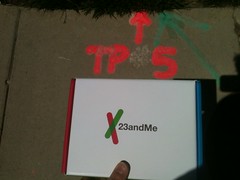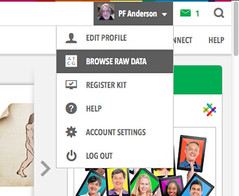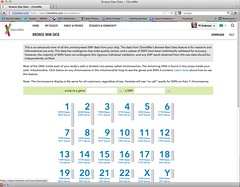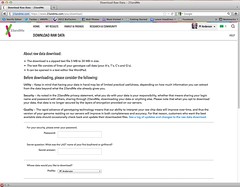Quantifying the impact of weak, strong, and super ties in scientific careers
Alexander Michael Petersen
PDF: http://arxiv.org/pdf/1509.01804v1.pdf
Soundbite: “We find that super ties contribute to above-average productivity and a 17% citation increase per publication, thus identifying these partnerships – the analog of life partners – as a major factor in science career development.”
Do we need another coffee house? The amenity space and the evolution of neighborhoods
César A. Hidalgo, Elisa E. Castañer
PDF: http://arxiv.org/pdf/1509.02868v1.pdf
Soundbite: “Neighborhoods populated by amenities, such as restaurants, cafes, and libraries, are considered to be a key property of desirable cities. … Finally, we use the Amenity Space to build a recommender system that identifies the amenities that are missing in a neighborhood given its current pattern of specialization.”
Liberating language research from dogmas of the 20th century
Ramon Ferrer-i-Cancho, Carlos Gómez-Rodríguez
PDF: http://arxiv.org/pdf/1509.03295v1.pdf
Soundbite: ” Those tenets can be summarized as a belief in the existence of word order constraints that cannot be explained by evolutionary processes or requirements of performance or learning, and instead require either (a) heavy assumptions that compromise the parsimony of linguistic theory as a whole or (b) explanations based on internal constraints of obscure nature.”
Interesting: “We submitted our commentary to PNAS but it was rejected. We hope that the availability of our submission helps to liberate language research from dogmas of the 20th century”
Estimating Reproducibility in Genome-Wide Association Studies
Wei Jiang, Jing-Hao Xue, Weichuan Yu
PDF: http://arxiv.org/pdf/1508.06715v1.pdf
Soundbite: “This can be used to generate a list of potentially true associations in the irreproducible findings for further scrutiny.”
Nucleosome positioning: resources and tools online
Vladimir B. Teif
PDF: http://arxiv.org/pdf/1508.06916v4.pdf
About: Gene Regulation Info
Includes: Nucleosome positioning datasets sorted by cell type
Combining exome and gene expression datasets in one graphical model of disease to empower the discovery of disease mechanisms
Aziz M. Mezlini, Fabio Fuligni, Adam Shlien, Anna Goldenberg
PDF: http://arxiv.org/pdf/1508.07527v1.pdf
Soundbite: “It is not unusual to observe a significant gene expression change in thousands of genes, the majority being a downstream, rather than the driver, effect (e.g. inflammation, drug response, etc) Additionally, and more importantly, there is a large heterogeneity in gene expression in cancer: many patients within the same subtype will appear to have an abberant expression. These variations are of unknown cause.”
Using Genetic Distance to Infer the Accuracy of Genomic Prediction
Marco Scutari, Ian Mackay, David Balding
PDF: http://arxiv.org/pdf/1509.00415v2.pdf
Soundbite: ” In human genetics, decay curves could be used study to what extent predictions are accurate and thus to improve the performance of medical diagnostics for the general population. In plant and animal breeding, on the other hand, it is common to incorporate distantly related individuals in selection programs to maintain a sufficient level of genetic variability.”
Population genomics of intrapatient HIV-1 evolution
Fabio Zanini, Johanna Brodin, Lina Thebo, Christa Lanz, Göran Bratt, Jan Albert, Richard A. Neher
PDF: http://arxiv.org/pdf/1509.02483v1.pdf
Soundbite: “In most patients, the virus populations was initially homogeneous and diversified over the years, as expected for an infection with a single or small number of similar founder viruses (Keele et al., 2008). In two patients, p3 and p10, the first sample displayed diversity consistent with the transmission of several variants from the same donor.”
Soundbite: “Our reasoning proceeds as follows. Figure 6B indicates that diversity accumulates over a time frame of 2-4 years, i.e., about 1,000 days. Recombination at a rate of 10−5/bp/day hits a genome on average every 100 bps in 1000 days. Mutations further apart than 100bps are hence often separated by recombination and retain little linkage consistent with the observed decay length in Figure 7.”
Inadequate experimental methods and erroneous epilepsy diagnostic criteria result in confounding acquired focal epilepsy with genetic absence epilepsy
Raimondo D’Ambrosio, Clifford L. Eastman, John W. Miller
PDF: http://arxiv.org/pdf/1509.01206v1.pdf
Soundbite: “Because the authors could not induce focal seizures by FPI, they ended up comparing absence epilepsy in their controls with absence epilepsy in FPI rats, and concluded that they look similar. They also used inappropriate epilepsy diagnostic criteria that cannot distinguish between focal non-convulsive seizures and genetic absence epilepsy. Moreover, the authors failed to consider all literature conflicting with their conclusion, and surmised similarities between the absence epilepsy in their rats with the focal seizures we induce by rpFPI.”
Reduction of Alzheimer’s disease beta-amyloid pathology in the absence of gut microbiota
T. Harach, N. Marungruang, N. Dutilleul, V. Cheatham, K. D. Mc Coy, J. J. Neher, M. Jucker, F. Fåk, T., Lasser, T. Bolmont
PDF: http://arxiv.org/pdf/1509.02273v1.pdf
Soundbite: “Our results indicate a microbial involvement in the development of Alzheimer’s disease pathology, and suggest that microbiota may contribute to the development of neurodegenerative diseases.”
Fractal Fluctuations in Human Walking: Comparison of Auditory and Visually Guided Stepping
Philippe Terrier
PDF: http://arxiv.org/pdf/1509.01913v1.pdf
Soundbite: “[B]ecause it can be assumed that AC and VC mobilize the same motor pathways, they can probably be used alternatively in gait rehabilitation. The efficiency of VC to enhance walking abilities in patients with neurological gait disorders needs further studies. However, the high gait variability induced by VC might have detrimental effects, for instance, a lower dynamic balance. This should be taken into account in the development of VC rehabilitation methods.”
The Brain Uses Reliability of Stimulus Information when Making Perceptual Decisions
Sebastian Bitzer, Stefan J. Kiebel
PDF: http://arxiv.org/pdf/1509.01972v1.pdf
Soundbite: “Our analysis suggests that the brain estimates the reliability of the stimulus on a short time scale of at most a few hundred milliseconds.”
Brain Model of Information Based Exchange
James Kozloski
PDF: http://arxiv.org/pdf/1509.02580v1.pdf
Coolness: IBM Neural Tissue Simulator (about NTS | NTS slides | 1st article)
Interplay between the local information based behavioral responses and the epidemic spreading in complex networks
Can Liu, Jia-Rong Xie, Han-Shuang Chen, Hai-Feng Zhang, Ming Tang
PDF: http://arxiv.org/pdf/1509.01321v1.pdf
Soundbite: “The spreading of an infectious disease can trigger human behavior responses to the disease, which in turn plays a crucial role on the spreading of epidemic…. Our finding indicates that, with the increasing of the response rate, the epidemic threshold is enhanced and the prevalence of epidemic is reduced.”
Identification and modeling of discoverers in online social systems
Matus Medo, Manuel S. Mariani, An Zeng, Yi-Cheng Zhang
PDF: http://arxiv.org/pdf/1509.01477v1.pdf
Soundbite: “We develop an analytical time-aware framework which shows that when individuals make choices — which item to buy, for example — in online social systems, a small fraction of them is consistently successful in discovering popular items long before they actually become popular. We argue that these users, whom we refer to as discoverers, are fundamentally different from the previously known opinion leaders, influentials, and innovators.”
Time-aware Analysis and Ranking of Lurkers in Social Networks
Andrea Tagarelli, Roberto Interdonato
PDF: http://arxiv.org/pdf/1509.02030v1.pdf
Soundbite: “Our goal in this work is to push forward research in lurker mining in a twofold manner: (i) to provide an in-depth analysis of temporal aspects that aims to unveil the behavior of lurkers and their relations with other users, and (ii) to enhance existing methods for ranking lurkers by integrating different time-aware properties concerning information-production and information-consumption actions.”

















